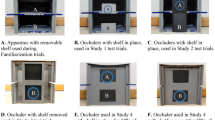Abstract
A number of studies have shown that dogs are sensitive to a human’s perspective, but it remains unclear whether they use an egocentric strategy to assess what humans perceive. We investigated whether dogs know what a human can see and hear, even when the dogs themselves are unable to see the human. Dogs faced a task in which forbidden food was placed in a tunnel that they could retrieve by using their paw. Whereas the dogs could not see the experimenter during their food retrieval attempts, the experimenter could potentially see the dog’s paw. In the first experiment, dogs could choose between an opaque and a transparent side of the tunnel, and in the second experiment, they could choose between a silent and a noisy approach to the tunnel. The results showed that dogs preferred a silent approach to forbidden food but they did not hide their approach when they could not see a human present. We conclude that dogs probably rely on what they themselves can perceive when they assess what the human can see and hear.



Similar content being viewed by others
References
Boesch C, Boesch-Achermann H (2000) The chimpanzees of the Tai forest. Oxford University Press, New York
Bräuer J, Call J, Tomasello M (2004) Visual perspective taking in dogs (Canis familiaris) in the presence of barriers. Appl Anim Behav Sci 88:299–317
Bräuer J, Call J, Tomasello M (2007) Chimpanzees really know what others can see in a competitive situation. Anim Cogn 10:439–448
Bräuer J, Call J, Tomasello M (2008) Chimpanzees do not take into account what others can hear in a competitive situation. Anim Cogn 11:175–178
Brosnan SF, de Waal FBM (2003) Regulation of vocal output by chimpanzees finding food in the presence or absence of an audience. Evol Commun 4:211–224
Call J, Bräuer J, Kaminski J, Tomasello M (2003) Domestic dogs (Canis familiaris) are sensitive to the attentional state of humans. J Comp Psychol 117:257–263
Dally JM, Emery NJ, Clayton NS (2006) Food-caching western scrub-jays keep track of who was watching when. Science 310:1662–1665
de Waal FBM (1986) Deception in the natural communication of chimpanzees. In: Mitchell RW, Thompson NS (eds) Deception: perspectives on human and nonhuman deceit. State University of New York Press, Albany, NY, pp 221–244
Emery NJ, Clayton NS (2001) Effects of experience and social context on prospective caching strategies by scrub jays. Nature 414:443–446
Flombaum JI, Santos LR (2005) Rhesus monkeys attribute perceptions to others. Curr Biol 15:447–452
Gácsi M, Miklósi A, Varga O, Topál J, Csányi V (2004) Are readers of our face readers of our minds? Dogs (Canis familiaris) show situation-dependent recognition of human’s attention. Anim Cogn 7:144–153
Hare B, Call J, Agnetta B, Tomasello M (2000) Chimpanzees know what conspecifics do and do not see. Anim Behav 59:771–785
Hattori Y, Kuroshima H, Fujita K (2007) I know you are not looking at me: capuchin monkeys’ (Cebus apella) sensitivity to human attentional states. Anim Cogn 10:141–148
Kaminski J, Call J, Tomasello M (2004) Body orientation and face orientation: two factors controlling apes’ begging behavior from humans. Anim Cogn 7:216–223
Kaminski J, Riedel J, Call J, Tomasello M (2005) Domestic goats, Capra hircus, follow gaze direction and use social cues in an object choice task. Anim Behav 69:11–18
Kaminski J, Call J, Tomasello M (2006) Goats’ behaviour in a competitive food paradigm: evidence for perspective taking? Behaviour 143:1341–1356
Kaminski J, Bräuer J, Call J, Tomasello M (2009) Domestic dogs are sensitive to a human’s perspective. Behaviour 146:979–998
Kummer H (1982) Social knowledge in free-ranging primates. In: Griffin DR (ed) Animal mind–human mind. Springer, Berlin, pp 113–130
Kummer H, Anzenberger G, Hemelrijk CK (1996) Hiding and perspective taking in long-tailed macaques (Macaca fascicularis). J Comp Psychol 110:97–102
Kundey SMA, De Los Reyes A, Taglang C, Allen R, Molina S, Royer E, German R (2010) Domesticated dogs (Canis familiaris) react to what others can and cannot hear. Appl Anim Behav Sci 126:45–50
Liebal K, Pika S, Call J, Tomasello M (2004) To move or not to move: how great apes adjust to the attentional state of others. Interact Stud 5:199–219
Melis AP, Call J, Tomasello M (2006) Chimpanzees (Pan troglodytes) conceal visual and auditory information from others. J Comp Psychol 120:154–162
Miklósi A (2007) Dog behaviour, evolution, and cognition, chap 6. Oxford University Press, Oxford, pp 137–150
Peterson RO, Ciucci P (2003) The wolf as a carnivore. In: Mech LD, Boitani L (eds) Wolves—behavior, ecology and conservation. University of Chicago Press, Chicago
Rosati AG, Hare B (2009) Looking past the model species: diversity in gaze-following skills across primates. Curr Opin Neurobiol 19:45–51
Santos LR, Nissen AG, Ferrugia JA (2006) Rhesus monkeys, Macaca mulatta, know what others can and cannot hear. Anim Behav 71:1175–1181
Schwab C, Huber L (2006) Obey or not obey? Dogs (Canis familiaris) behave differently in response to attentional states of their owners. J Comp Psychol 120:169–175
Stulp G, Emery NJ, Verhulst S, Clayton NS (2009) Western scrub-jays conceal auditory information when competitors can hear but cannot see. Biol Letters 5:583–585
Udell MAR, Dorey NR, Wynne CDL (2011) Can your dog read your mind? Understanding the causes of canine perspective taking. Learn Behav 39:289–302
Virányi Z, Topál J, Gácsi M, Miklósi A, Csányi V (2004) Dogs respond appropriately to cues of humans’ attentional focus. Behav Processes 66:161–172
Watts DP, Mitani JCC (2001) Boundary patrols and intergroup encounters in wild chimpanzees. Behaviour 138:299–327
Xitco MJ, Gory JD, Kuczaj SA (2004) Dolphin pointing is linked to the attentional behavior of a receiver. Anim Cogn 7:231–238
Acknowledgments
We are deeply grateful to the dog owners who let their dogs participate in our study. We further thank Susanne Zachow, Helene Petterson, Diana Wiedemann, and Alexander Siller for helping with data collection. We also thank Kerstin Esau for coding for inter-observer reliability purposes.
Conflict of interest
We declare that the experiments comply with the current laws of Germany. We also declare that we have no conflict of interest.
Author information
Authors and Affiliations
Corresponding author
Rights and permissions
About this article
Cite this article
Bräuer, J., Keckeisen, M., Pitsch, A. et al. Domestic dogs conceal auditory but not visual information from others. Anim Cogn 16, 351–359 (2013). https://doi.org/10.1007/s10071-012-0576-9
Received:
Revised:
Accepted:
Published:
Issue Date:
DOI: https://doi.org/10.1007/s10071-012-0576-9




